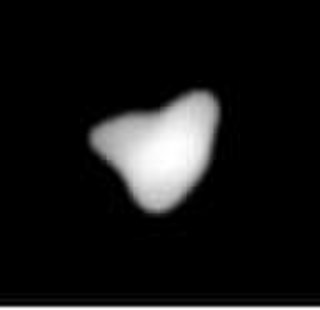
Urania is a large main-belt asteroid that was discovered by English astronomer John Russell Hind on July 22, 1854. It was his last asteroid discovery. This object is named after Urania, the Greek Muse of astronomy. Initial orbital elements for 30 Urania were published by Wilhelm Günther, an assistant at Breslau Observatory. It is orbiting the Sun with a period of 3.64 years and is spinning on its axis once every 13.7 hours.

Freia is a very large main-belt asteroid. It orbits in the outer part of the asteroid belt and is classified as a Cybele asteroid. Its composition is very primitive and it is extremely dark in color. Freia was discovered by the astronomer Heinrich d'Arrest on October 21, 1862, in Copenhagen, Denmark. It was his first and only asteroid discovery. It is named after the goddess Freyja in Norse mythology.

Peitho is a main-belt asteroid. It is probably an S-type asteroid, suggesting a siliceous mineralogy. It was discovered by R. Luther on March 15, 1872, and named after one of the two Peithos in Greek mythology. There have been two observed Peithoan occultations of a dim star: one was in 2000 and the other in 2003.
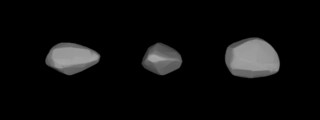
Aethra is a metallic asteroid and Mars-crosser on an eccentric orbit from the asteroid belt. It measures approximately 40 kilometers in diameter.

165 Loreley is a main-belt asteroid that was discovered by C. H. F. Peters on August 9, 1876, in Clinton, New York and named after the Lorelei, a figure in German folklore.

196 Philomela is a large and bright main-belt asteroid. It is an S-type asteroid.

Vincentina is a fairly large main belt asteroid.
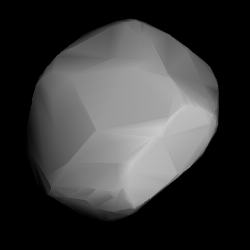
Hypatia is a very large main-belt asteroid that was discovered by Russian astronomer Viktor Knorre on July 1, 1884, in Berlin. It was the third of his four asteroid discoveries. The name was given in honour of philosopher Hypatia of Alexandria. Based upon the spectrum, it is classified as a C-type asteroid and is probably composed of primitive carbonaceous material. Like many asteroids of this type, its surface is very dark in colour.
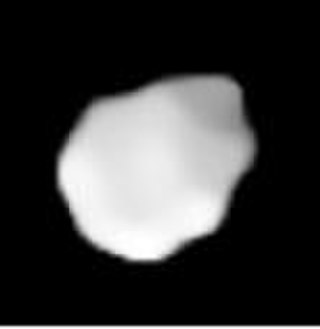
Eleonora is a large, stony main-belt asteroid that was discovered by the French astronomer Auguste Charlois on January 17, 1893, in Nice.
Ninina is a large main-belt asteroid. It was discovered by Auguste Charlois on February 11, 1893, in Nice. The reference of its name is not known, though Ninine is a French personal name.

360 Carlova is a very large main-belt asteroid. It is classified as a C-type asteroid and is probably composed of carbonaceous material. The asteroid has a convex, roughly ellipsoid shape. The sidereal rotation period is 6.1873 hours with an axis of rotation along the ecliptic coordinates (l, b) = (95°±3°, 40°±1°). It was discovered by Auguste Charlois on 11 March 1893 in Nice.
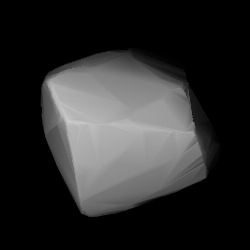
361 Bononia is a very large, resonant Hilda asteroid located in the outermost region of the asteroid belt. It is classified as a D-type asteroid and is probably composed of organic rich silicates, carbon and anhydrous silicates. It was discovered by Auguste Charlois on 11 March 1893, in Nice, and assigned the prov. designations A893 EF and 1893 P.
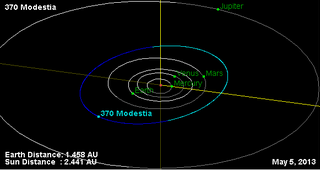
Modestia is probably a typical Main belt asteroid. It was discovered by Auguste Charlois on 14 July 1893 in Nice.

Bohemia is a sizeable Main belt asteroid. It was discovered by Auguste Charlois on 16 July 1893 in Nice.

Palma is one of the largest main-belt asteroids. It is a B-type asteroid.

373 Melusina is a large Main belt asteroid. It is classified as a C-type asteroid and is probably composed of carbonaceous material. It was discovered by Auguste Charlois on 15 September 1893 in Nice.

Aspasia is a large main-belt asteroid that was discovered by French astronomer Auguste Charlois on 9 December 1895 in Nice. It is classified as a CX-type asteroid.
Bertholda is a very large main-belt asteroid. It was discovered by Max Wolf on September 7, 1896, in Heidelberg, Germany. The object is part of the Cybele asteroid group, and is classified as a P-type asteroid.
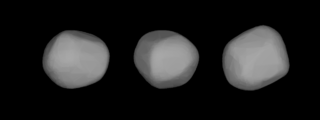
Diotima is one of the larger main-belt asteroids. It is classified as a C-type asteroid and is probably composed of primitive carbonaceous material.

776 Berbericia is a minor planet orbiting the Sun. A main-belt C-type asteroid, it was discovered on 24 January 1914 by astronomer Adam Massinger at Heidelberg Observatory in southwest Germany. It was named by Max Wolf in honor of Adolf Berberich (1861–1920), a German astronomer. The spectra of the asteroid displays evidence of aqueous alteration.


















